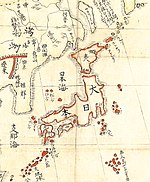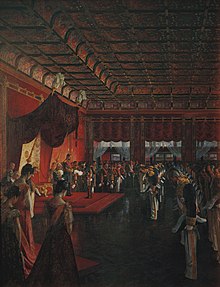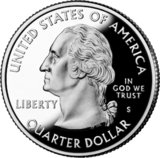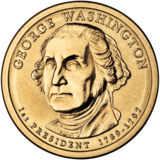User:Kizhiya/sandbox
sandbox
History of Japan[change | change source]
The Japanese people call their country "Nihon" or "Nippon",[1] which means "the origin of the Sun" in Japanese. Japan is a monarchy whose head of state is called the Emperor.[1] Japan is the oldest monarchy in the world, lasting more than 2,000 years.[2]
History of Japan[change | change source]
| History of Japan |
|---|
 |
The first people in Japan were the Ainu people and other Jōmon people. They were closer related to Europeans or Mongols.[3] They were later conquered and replaced by the Yayoi people (early Japanese and Ryukyuans). The Yayoi were an ancient ethnic group that migrated to the Japanese archipelago mainly from southeastern China during the Yayoi period (300 BCE–300 CE). Modern Japanese people have primarily Yayoi ancestry at an average of 97%.[4][5] The indigenous Ryukyuan and Ainu peoples have more Jōmon ancestry on the other hand.
The earliest records on Japan are from Chinese documents. One of those records said there were many small countries (in Japan) which had wars between them and later a country, ruled by a queen, became the strongest, unified others, and brought peace.
古代[change | change source]
The Japanese began to write their own history after the 5th and 6th centuries, when people from Korea and China taught Japan about the Chinese writing system. [6] このころ、大和朝廷が成立しました。彼らの子孫が今のエンペラーです。 日本は、自分たちが話す言葉に合わせて文字を書きました。Chinese writing system を変えました。独自の文字を作りました。「ひらがな」と「かたかな」です。
Japan's neighbours also taught them Buddhism.[6] The Japanese changed Buddhism in many ways. For example, Japanese Buddhists used ideas such as Zen more than other Buddhists.[6]
奈良時代[change | change source]
平安時代[change | change source]
日本は近所の人たちとの行き来をやめました。 平安時代は、400年続きました。京都が都になりました。朝廷と貴族が中心となって政治を行いました。遠くの地方を治めるために、中央政府は日本のあちこちに役人を送りました。前半はとても平和でした。日本独自の文化が発展しました。貴族の女性たちが帝の政府で働きました。紫式部が源氏物語を書きました。ほかにもたくさんの女性が物語たちを書き残しました。貴族の誰もが和歌を詠みました。 後半。武士が勢いを持ってきます。
中世[change | change source]
- Heian period Gallery
-
Construction of Washington portrait at Mount Rushmore, c. 1932.
-
Washington is commemorated on a quarter.
-
Washington on a dollar coin.
Sengoku[change | change source]
安土桃山時代[change | change source]
Japan had some contact with the Europeans in the 16th century. The Portuguese were the first Europeans to visit Japan. Later, the Spanish and Dutch came to Japan to trade. Also, they brought Christianity. Japan's leaders welcomed them at first, but because Europeans had conquered many places in the world, the Japanese were scared they would conquer Japan too. So the Japanese did not let the Europeans come into Japan anymore, except in a small area in Nagasaki city.Many Christians were killed.
この時代は戦いが続きました。地方の領主たちが争って、京都に行こうとしました。京都のエンペラーから、将軍だと認めてもらうためです。 特に有名な領主は、Oda Nobunaga、Toyotomi Hideyoshi、Tokugawa Ieyasu です。 織田信長ははじめて天下統一に近づきました。彼は新しいものが好きでした。歓迎しました。 エンペラーは豊臣秀吉を関白にしました。彼は農民から領主になりました。検地を行いました。明を征服しようとしました。朝鮮まで行きました。途中で死にましたので、やめました。 秀吉の死後、徳川家康が豊臣家の一族を滅ぼしました。
- Cultural depictions of George Washington
-
Construction of Washington portrait at Mount Rushmore, c. 1932.
-
Washington is commemorated on a quarter.
-
Washington on a dollar coin.
近世[change | change source]
江戸幕府[change | change source]
Only the Chinese, Korean, and Dutch people were allowed to visit Japan, in the end, and they were under careful control of the Japanese government. Japan was opened for visitors again in 1854 by Commodore Matthew Perry, when the Americans wanted to use Japanese ports for American whale boats. Perry brought steamships with guns, which scared the Japanese into making an agreement with him.[7]

This new contact with Europeans and Americans changed the Japanese culture. The Meiji Restoration of 1868 stopped some old ways and added many new ones. The Empire of Japan was created, and it became a very powerful nation and tried to invade the countries next to it. It invaded and annexed Ryukyu Kingdom, Taiwan, and Korea. It had wars with China and Russia: the First Sino-Japanese War, the Boxer Rebellion, the Russo-Japanese War, World War I.
In 1918, World War I allowed Japan, which joined the side of the victorious Allies, to capture German possessions in the Pacific and in China. which grew to become a part of World War II when Japan became allies with Nazi Germany and Fascist Italy.

In 1941, Japan attacked Pearl Harbor in Hawaii, a water base of the United States, and destroyed or damaged many ships and airplanes. This started the United States' involvement in World War II. American and Japanese forces fought each other in the Pacific. Once airbases were established within range of the Japanese mainland, America began to win, and started dropping bombs on Japanese cities. America was able to bomb most of the important cities and quickly brought Japan close to defeat. To make Japan surrender, the United States dropped two atomic bombs on the cities of Hiroshima and Nagasaki, killing 150,000 Japanese citizens. Soon after this the Soviet Union began to fight against Japan, and the Japanese army in Manchuria lost. Japan surrendered and gave up all the places it took from other countries, accepting the Potsdam Proclamation. The United States occupied Japan from September 1945 to April 1952 and forced it to write a new constitution, in which it promised to never go to war again.
Japan was granted membership in the United Nations in 1956. A period of record growth propelled Japan to become the second-largest economy in the world.On March 11, 2011, Japan suffered one of the largest earthquakes in its recorded history, triggering the Fukushima Daiichi nuclear disaster. On May 1, 2019, after the historic abdication of Emperor Akihito, his son Naruhito became Emperor, beginning the Reiwa era. On 8 July 2022, former Prime Minister Shinzo Abe was assassinated while giving a campaign speech in Nara.
- ↑ 1.0 1.1 "Japan". CIA World Factbook. CIA. Archived from the original on 2015-12-20. Retrieved 2016-06-19.
- ↑ Wong-Anan, Nopporn (3 May 2019). "Emperor Naruhito and Japan's lonely republicans". BBC. BBC. Retrieved 2022-01-18.
{{cite news}}:|archive-date=requires|archive-url=(help) - ↑ Brace, C. Loring (2001). "Old World sources of the first New World human inhabitants: A comparative craniofacial view". Proceedings of the National Academy of Sciences of the United States of America. 98 (17): 10017–10022. Bibcode:2001PNAS...9810017L. doi:10.1073/pnas.171305898. PMC 55570. PMID 11481450.
- ↑ https://www.biorxiv.org/content/biorxiv/early/2019/03/15/579177.full.pdf
- ↑ "「縄文人」は独自進化したアジアの特異集団だった! : 深読み". 読売新聞オンライン (in Japanese). 2017-12-15. Retrieved 2019-12-19.
- ↑ 6.0 6.1 6.2 "Early Japan (until 710)". japan-guide.com. Retrieved 2009-06-16.
- ↑ "Perry & Opening of Japan". history.navy.mil. 2009. Archived from the original on December 4, 2002. Retrieved December 1, 2011.




